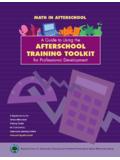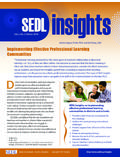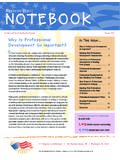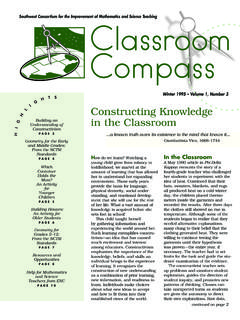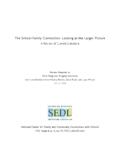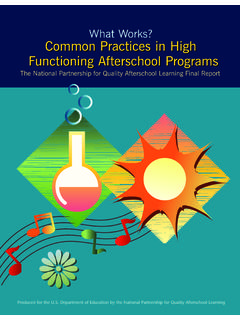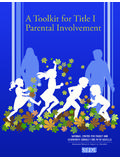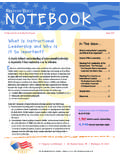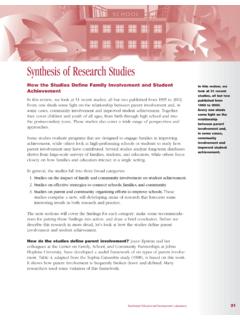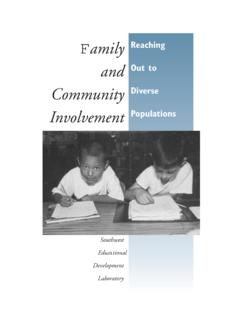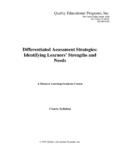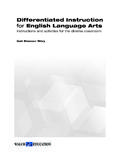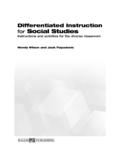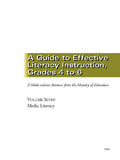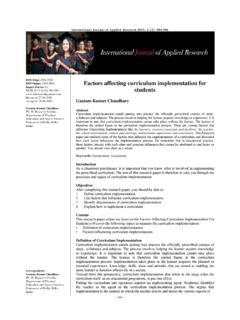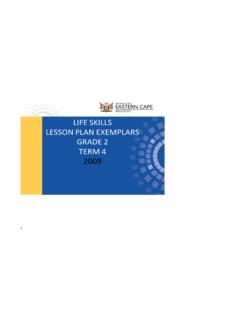Transcription of Differentiated Instruction in the Foreign Language ...
1 1 LOTELOTELOTELOTELOTE CEDCEDCEDCEDCEDC ommuniqu Communiqu Communiqu Communiqu Communiqu The Communiqu ispublished by the LanguagesOther Than English Centerfor Educator DevelopmentEditors: Elaine PhillipsLillian King MeidlingerLayout Editor: Chuck Reese Issue 6 Differentiated Instruction in the Foreign Language Classroom:Meeting the Diverse Needs of All LearnersToni Theisen, Loveland, COThe real voyage of discovery lies not in seeking newlandscapes but in having new eyes. (Petras, 1995)How can this profound quote by Marcel Proust help all of us metaphoricallyunderstand the powerful relationship of our minds, emotions, and bodies to ourdifferent ways of knowing; the varied paces at which we learn; and the input weneed for motivation and success? As teachers, we continue to search and explorenew ways to design and deliver Instruction in order for our students to reach theirlearning potential, starting them from where they are and moving them forward ona learning continuum.
2 But for many students, the traditional approaches to learningseem limiting, and many of them feel frustrated and discouraged. With the adventof studies in cognitive science and brain-based learning research along with thepowerful advancement of technologies, we are beginning to unlock the mysteriesof the human brain and its possibilities. Educational research also enables us tobetter identify learner variables that can affect a student s performance (Gregory& Chapman, 2002). We are starting to open our new Language classrooms are tapestries of the world around us. Students cometo us with varying ability levels, a myriad of Language and cultural backgrounds,an abundance of interests, and an assortment of learning profiles. These studentsneed inspiring, engaging lessons that will permit them to reach their highestpotential and meaningful tasks that are relevant both to them and to the world inwhich they live.
3 They desire a supportive learning environment which promotesdiversity, nurtures creativity, acknowledges that they learn at varied rates and indifferent ways, recognizes their strengths, and honors everyone s work. Thesestudents need variety, choices, challenges, complexity, and opportunities todemonstrate their capabilities. They need to experience Differentiated instructionalopportunities (Heacox, 2002).What is Differentiated Instruction ?In a level one Spanish class, students want to find out more about the countrieswhere Spanish is spoken, so the teacher provides a variety of resources(including sample texts, authentic documents, and Internet sites) that studentscan choose from in order to gather more in-depth information. In a level threeSpanish class, students read and create a graphic representation (mind map) ofan Aztec legend. Each student then chooses one other Aztec or Mayan legendto read and study from the four provided by the teacher.
4 Grouped according tothe legend each has chosen, students read and interpret it, then demonstratetheir understanding of the legend and its connection to their own lives bycreating a skit, designing a children s book, or inventing a product of theirchoice that will be presented to the II students are studying the weather. The teacher creates seven learningcenters where students can practice various aspects of the weather unit, includinglistening activities, a video clip of a TV weather report, and German weather mapsfrom a newspaper. Students then choose four of the seven centers that best helpthem use the weather unit and complete the activities at their chosen evaluating students progress, the teacher determines that one third of theclass knows the vocabulary, structure and culture for this unit very well and couldeasily perform the appropriate real world functions like helping a friend pack clothesfor a trip to Austria.
5 One third of the class understands most of the unit and hasperformed most of the interpersonal and interpretive tasks with just some third of the class is experiencing a considerable degree of difficulty and needs2more direct Instruction and concrete examples. In orderto provide challenging practice to all, the teacher tiersthree different homework assignments from the bookand ancillaries. Students do the assignment that bestmatches their readiness of the preceding activities and strategies areexamples of differentiation. Differentiated Instruction isa philosophy of teaching and learning which recognizesthat each learner is unique. Rigorous, relevant, complexand flexible, Differentiated Instruction is a response tothat uniqueness. Consequently, in a differentiatedclassroom, not every student is doing exactly the samething in exactly the same way at exactly the same , Differentiated Instruction is not merely a set ofstrategies and activities that challenges the learner in avariety of ways, but rather a belief system that proclaimsthat learners with all their diversity come to ourclasses with potential ready to be tapped.
6 Differentiationis an effective way for teachers to offer meaningfulinstruction delivered around challenging content anddesigned to meet the needs of students at theirappropriate levels and to help them achieve maximumgrowth (Center for Advanced Student Learning, 2001).A Differentiated classroom offers a variety of learningoptions to tap into different readiness levels, interestsand learning profiles. In a Differentiated classroomthe teacher uses (1) a variety of ways for students toexplore curriculum content, (2) a variety of sense-making activities or processes through whichstudents can come to understand or own information and ideas, and (3) a variety of optionsthrough which students can demonstrate or exhibitwhat they have learned (Tomlinson, 1995, p. 1).When Differentiated instructional strategies are used,there is more access to learning by more students, moreeffective use of time, and more evidence of motivatedstudents.
7 The art and science of teaching emerge(Tomlinson, 1999).The Core of Differentiated InstructionIn order to prepare for differentiation, sound teachingprinciples must be honored and a quality curriculum mustbe in place. Applying standards while designing andorganizing Instruction , a teacher must be clear on whatall students need to know, understand, and be able todo at the end of the unit. The teacher is familiar withstudent differences that affect the unit and builds onthese differences, making adjustments in the content ofthe unit, the multiple ways students process the content,and the various products they create in order todemonstrate what they have learned. For example, apre-test or a questionnaire can be used to check forprior knowledge of the content, student reflective logscan be examined to check for previous challenges, pastgrades can be used to determine progress andreadiness levels, a multiple intelligences checklist canbe administered to check for varied learning profiles, oran inventory can be taken to determine interests.
8 Toenhance learning for all students, the goals ofdifferentiated Instruction include: establishing a balancebetween a student-centered and teacher-facilitatedclassroom, providing opportunities for students to workin a variety of formats, developing Instruction aroundthe standards and the big picture concept of the unit, designing challenging and respectful tasks for all, andmeeting curriculum standards and requirements whilemaximizing student growth and individual is based on sound research. It puts thelearning needs of students at the center of instructionaldesign (Tomlinson, 1999).Differentiating Curricular ElementsDifferentiated Instruction usually implies modificationsor variations in response to student needs in one or moreof the following areas: content, process or refers to the input of the unit: ideas, concepts,information and facts. It is what the student must knowand understand as a result of the lesson.
9 Content isdifferentiated by focusing on the unit s most relevant andessential components and varying them to meetlearners needs by providing them choices. For example,if some students need more time to grasp the essentialskills needed for the unit, the teacher might provide themmore direct Instruction , more concrete examples andpractice. Other students may quickly understand theconcepts and need to be challenged by more complexactivities (Berger, 1991).Content can also be modified by providing a variety oftexts: simpler or more advanced, authentic documentsor adapted ones, electronic or print or simply a varietyof text types such as brochures, music, film, field trips,guest speakers, Total Physical Response Storytelling,etc. A learning center a classroom area containing acollection of materials or activities designed to teach,reinforce, or extend a particular concept or skill (Centerfor Advanced Student Learning, 2001) can be used todifferentiate for content.
10 Learning Centers for ExploringLiterature (Figure 1) is one such example in whichstudents gain background knowledge of a story s setting,the historical and cultural perspectives in which it takesplace, and the biographical background of the refers to the ways students make their ownsense of the content or input. Process is the how ofteaching. To modify the process, the teacher can applya variety of flexible grouping strategies such as abilitygrouping, interest grouping, or grouping by learningprofile. Gardner s Multiple Intelligences Theory1 (Lazear,3 There are six learning centers that will help you gain perspective into the piece of literature that we arereading in class. Examine the choices and visit four of the centers that interest you. Do the assigned activityfor each center you choose, and fill in your self-reflection log. After everyone has completed the centeractivities within the time frame, you will be assigned to groups of three to discuss your findings and how thisbackground knowledge is helping you better understand the piece of Log As you visit each center, respond to the following in the target Language (only for the centers visited).)
